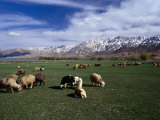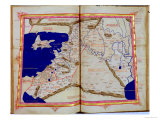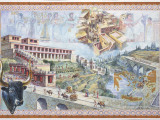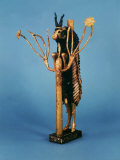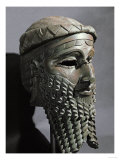|
|
features:
• Article entitled "Tribes to Empires: The Growth of Civilization"
• Historical map of the Middle East with information about civilizations
• Chronology of the Middle East timeline
• Inset map of the major cities of the Third Millennium
• A map showing the peak of Assyrian and Neo-Babylonian empires
• Inset map of early agricultural sites from 10,000-4,000 BC
• Illustrations and information about artifacts |
|
|
|
(1979 information)
TRIBES TO EMPIRES: THE GROWTH OF CIVILIZATION
It was the springtime of a new epoch. As the long age of ice eased its grip upon the Earth, warming winds swept across southwestern Asia. Into the uplands spread seasonal grasses – wild wheat and barley, nutritious and abundant. Small bands of hunter-gatherers roamed these hills and steppes, stalking deer, gazelles, onager, and wild sheep and goats and searching the land for whatever sustenance nature provided. They differed little in their way of life from many thousands of generations of their ancestors. Yet they stood at the threshold of changes more far-reaching than any since the taming of fire. The year was 10,000 B.C., and in the lush hills beside the eastern Mediterranean, a people known to archeologists as the Natufians were taking the first tentative steps toward building permanent settlements–and tasting a new freedom, a liberation from eternal wandering. With it came opportunities never known before: to live and grow in numbers beyond small bands, to store foods beyond the moments needs, and to develop the first inklings of understanding toward controlling the plants and animals around them. Much about the Natufians remains unknown. Much may never be known. But one thing is clear–they had made their mark at a fixed locale, a home, and mankind had taken a giant step toward building his first civilizations.
FIRST FARMERS, FIRST VILLAGERS
Who first took hoe and planted seeds in expectation of harvest? Who first turned his hand from hunting to herding? The Book of Genesis names the sons of Adam and Eve, born after banishment from Eden: “Now Abel was a keeper of sheep, and Cain a tiller of the ground.” The oldest traces yet found of early herdsmen have been discovered in the foothills of the Zagros Mountains. There, digging in the rubble of an early settlement site called Zawi Chemi Shanidar, archeologists unearthed bones of sheep from 9000 B.C. Their analysis suggests that men had already begun to keep and nurture herds of what had once been wild prey.
At Mureybit on the banks of the Euphrates, careful sifting of the soil revealed wheat seeds far from the uplands where they occurred naturally. In response to pressures–perhaps population growth or changes in climate–men moved from locations where natural food sources supplied their needs to poorer areas. At first they made yearly treks to reap the wild grains. Eventually, in other settlements, the harvesters carried seeds back to sow in the valleys.
With this newfound control over their destinies, villagers began to construct communities larger and more complex than any seen before. By 8000 B.C., beside a perennial spring near the Dead Sea's arid shores, stone walls and a tower some thirty feet high enclosed and protected a population of about 2,500 in the city of Jericho. Perhaps 10,000 townspeople dwelt at Catal Huyuk in Antolia two thousand years later. These farmers and herders of cattle venerated bulls and worshiped a mother goddess, painted their walls with hunting scenes of startling vitality, and shaped objects of lustrous obsidian quarried from deposits a hundred miles to the northeast–an indication of prehistoric trade routes.
Selective breeding, intentional or not, slowly transformed herdsmen's goats, sheep, cattle, and pigs into smaller, more tractable versions of their wild forebearers. Similarly, cultivation resulted in domesticated strains of wheat and barley better suited to the harvesting. The agricultural revoluton spread along the great rivers of the Middle East during the sixth millennium. As migrating farming people from the hills or oases of the Sahara swelled the population of the Nile Valley, hunter-gatherers turned to tilling the soil. Villages appeared like mushrooms beside the Tigris and Euphrates. On a steppe east of Mesopotamia, around 5,000 B.C., yet another innovation occurred that would shape man's future: Waters flowed from their natural channels through simple canals to reach new fields–the beginnings of a vast irrigation network that would one day lace the plain where civilizations was born.
BIRTH OF THE CITY
“In Dilmun the raven utters no cries ... the lion kills not, the wolf snatches not the lamb ...” With a power and certainty echoed time and again in men's vision of paradise, the legend of a shining city where death holds no sway comes down to us from the land where cities first appeared–Sumer. Its fertile soil gave rise to Ur, Uruk, Eridu, Babylon of an imperial destiny, and the many other populous city-states that formed with world's oldest civilization.
Where canals led the life-giving waters of the Tigris and Euphrates onto Sumerian fields, cereals grew as rich in yield as in the heart of today's North American wheat belt. Towns proliferated amid abundance and, sometime in the fourth millennium, crystallized with startling rapidity into teeming urban centers. Each worshipped its own god. Priests mediated between the people and their diety, whose whimsy controlled the terrifyingly unpredictable rivers tha determined each year's fortunes. Councils of citizens may have chosen the first city leaders, probably to lead them into battle. Eventually, kings emerged to rule burgeoning populations and control complex irrigation systems. These were permanent rulers who owned great estates, built elegantly furnished palaces, and traveled to the afterworld surrounded by precious objects that had been theirs in life.
As time passed, retinues of scribes and palace officials grew to administer the cities' day-to-day affairs and meticulously record the tithes and transactions of farmers who raised vegetables, dates, pomegranates, and grapes, in addition to staple cereals. Ships, laready sturdy enough for seagoing voyages, ranged up the rivers with rare goods from distant lands. Metals came in along overland routes, paid for with wool woven by thousands of workers in the first large-scale industry. As cities grew throughout Mesopotamia and in Persia, Anatolia, and the Levant, armies marched against one another in spring, the season of war. (Personal note - isn't it interesting that the Roman god of war, Mars, is the the root of the spring month of March?)
Egypt lay like a land of dream, removed from the tumultuous world by deserts, engrossed in its own destiny. There god-kings ruled a sinuous kingdom along the Nile, ordered by the river's dependable rise and fall. Successive pharaohs, powerful and remote, built monumental sepulchers in pyramid form until economic problems, drought,andfamine lead to the end of the dynastic line around 2200 B.C. Within two centures another dynasty arose, modeled on the old, which carried on a rich, sigular culture that equaled, but was rarely influenced by, those developing in the lands beyond.
THE ARTS OF CIVILIZATION
Among many milestone achievements of those early cutures, the development of writing stands in the forefront. Cuneiform symbols impreinted on tablest of clay from Sumer's rockless plain and hieroglyphs carved on Egyptian stone appered before 3000 B.C. Today archeologists search deserted mounds where bustling cities once stood, digging for the testaments left by ancient scribes.
Tablets found at Ugarit, a thriving trade city in northern Syria, chronicle seaborne commerce with other Mediterranean ports: box and juniper wood for building, olive oil, and wine for nobles' tables. The successful administration of growing kindoms, one of civiliation's most necessary skill, rested on writing. So, to did the codification of nationwide laws, a revolutionary concept exemplified by Hammurapi's famous stela. Babylonian priests stood nightly watch to record and decipher the wheeling rhythms of the celestial clock, contributing to the development of astronomy and higher mathematics. The invention of the alphabet around 1500 B.C. democratized writing, transforming it from an arcane art into a more readily understood medium.
Men's notions of their godsevolved as their horizons broadened. The many separate Sumeriancity godsfused into a pantheon during the third milennium B.C., and later tablets from Ugarit in Syria depict a Phoeniciancosmology with recognizable Mesopotamian elements. Other rchives preserve the Akkadian Epic of Gilgamesh, one of the oldest literary narratives. The late second millennium B.C. has been called “the first international age,” when statesmanship and the interchange of ideas quickened. It was during this era that the Pharaoh Akhenaten conceived of a single universalgod embodied in the sun. the enduring religiousachievement of the age, however, was that of the Hebrews and their concept of monotheism: a God invisible, incorporeal,and the creator of the universe.
Paralleling the spread of writing and the growth of new ides were advances in art, crafts, and technology. Fine works of gold, silver, and lapis lazuli adorned the great stone temples and palaces of Egypt and the clay-brick edifices of Mesopotamia. Copper implements were in household use in the third millennium, to be gradually replaced by bronze after 2000 B.C. Music and games enlivened court life. In the art of each people may be seen something of their character, from the serene sculptures of the Egyptians to the Assyrians' ferocious tableaux of hunting and war.
THE COMING OF EMPIRES
Fear was the weapon by which the Assyrians conquered the greater part of their known world. Except for the brief and unstable rise of Akkad around 2300 B. C., no single kingdom exerted sway over what could be called an empire until the Assyrians of the first millennium came upon their neighbors “like the wolf on the fold,” in Lord Byron's words. They exiled or slaughtered enemies and rebels with utter ruthlessness. Yet despite their cruelty they exhibited a talent for administration over those of their subjects too cowed or wise to resist. The Neo-Babylonians who came after imitated their successes, and they, too, ruled a great territory until, under the weak hand of Nabonidus, they faced the armies of a more efficient empire builder, Cyrus the Great of Persia. Babylonia fell, and the initiative of history shifted to Persia and Greece, and to the other vital young nations west of the Aegean. Within a few centuries Babylon's palaces and hanging gardens had gone the way of the splendors of Ur and Nineveh before them: tumbled ruins on the sere (arid, parched, desiccated) Mesopotamian plain, empty amid the graves of the kings who built them, forlorn beside the endless flow of the rivers that nourished them.
CHRONOLOGY OF THE MIDDLE EAST
Cradle of Civilization and Fertile Crescent are names given to the sickle-shaped swath of green that arcs along the Tigris and Euphrates Rivers, and across the rain-catching hills of the Levantine coast, the “land flowing with milk and honey,” here, as well as in the Nile Valley and in nearby lands linked to them by trade and geography, unfolded the pageant of the world's first civilizations, a story of war and invention, and of peoples vigorous with the power of new-found knowledge.
–––––––––––––––
MINOAN Europes' first great civilization developed on the island now known as Crete from about 3000 to 1450 B.C. A peaceful people, possibly of middle Eastern origin, the Minoans encouraged the arts, built sumptuous palaces, and sent their fleets trading through the Aegean and Mediterranean.
MYCENAE - The heroic tales of Homer immortalized the Mycenaeans, who emerged as a power about 1650 B.C. More warlike than the Minoans whom they eclipsed, these mainland Greeks forged weapons of bronze and buried their nobility with masks of gold. The civilization crumbled in the 12th century B.C.
PHOENICIA - Master sailors and traders and developers of the alphabet, the Phoenicians became intermediaries for cltrual exchange between Mesopotamia, Egypt, and Mediterranean. A people long rooted to the northern coast of Canaan, the Phoenicians came into their own about 1200 B.C., forming a network of city-states and colonies from Tyre to the Atlantic. The Romans crushed Carthage, one of the last Phoenician culture, in 146 B.C.
EGYPT -The first seeds of the culture that bloomed along the Nile sprouted around 3050 B.C., when Menes, the first pharaoh, united Upper and Lower Egypt. Magnificent tombs and pyramids sprang up, colossal temples honored a vast pantheon of dieties, hieroglyphs were graven in stone, and the Nile's predictable floods were utilized for natural irrigation.
About 1670 B.C. the chariots of the Hyksos, fierce Asiatic nomads, rolled across the Sinai. The invaders ruled Egypt until they were expelled in 1566 B.C. With an eye to protecting the homeland, Thutmose III drove northward to the Euphrates. Thus began serious conflicts with other major powers and later defeats at the hands of Assyrian, Babylonian, and Persian rulers.
KUSH - Excellent horsemen and cattle raisers, the people south of the 2nd Cataract of the Nile were part of the Egyptian Empire for long periods, but eventually established the independent kingdom of Kush. As civil disorder weakened Egypt in the eighth century B.C., Kushite rulers marched north and ruled as pharaohs. In 664 B.C. the invading Assyrians hurled them back. The Kushites built a large-scale smelting industry in the ore-rich region around Meroe.
PUNT - Exotic goods – frankincense, myrrh, ivory,and ebony – flowed from the regions of the Gulf of Aden through the fabled land of Punt. Its location, perhaps as far south of Egypt as the Horn of Africa, has never been determined. Much of what is known about Punt was learned from a relief in the Egyptian temple of Deir el Bahri, built around 1490 B.C. in Western Thebes. The artwork vividly depicts trade between the rulers of Punt and emissaries of Queen Hatshepusut.
ARABIA FELIX - The Biblical Queen of Sheba ruled one of five ancient kingdoms that flourished in the region of Arabia Felix in the 14th century B.C. She journeyed to Jerusalem and gave Solomon “an hundred and twenty talents of gold, and of spices very great store, and precious stones.” Frankincense and myrrh, the aromatic resins of two trees that grow only in southern Arabia and the Horn of Africa, were the mainstays of the economy. Trade was stimulated by the domestication of the camel, and caravans wound northward.
SUMER - The world's first known civilization sprang from the confluence of the Tigris and Euphrates Rivers. Here about 3500 B.C. the Sumerians coalesced their scattered settlements into walled cities. Four hundred years later scribes were recording transactions by pressing reeds into clay tablets, forming wedge-shaped, or cuneiform, characters. Thus writing was born. The Sumerian numerical system, based on 60, still orders our hours and minutes. In 2340 B.C. Akkadian conquerors swept in from the northwest, the first of a steady stream of Semitic and Indo-European invaders. They assimilated many elements of Sumerian culture into their own, including the concepts of city life, civic organizaiton, law, and monumental architecture.
BABYLONIA - An eye for an eye, commanded the code of laws of Hammurapi, who nurtured Babylon's first great flowering from 1792 to 1750 B.C. United Sumer and Akkad under his rule, he instituted a hightly organized administration, including courts and a system for enforcement of laws. Commerce and the arts flourished, temples rose, and the study of astrology yielded a practical calendar. After successive invasions by Kassites, Elamites, and Assyrians, Babylon again became independent under Naborpolassar around 600 B.C., but Cyrus the Great of Persia ended the kingdoms glory in 539 B.C.
AKKAD - Sargon, first of the Akkadian kings, was one of the first monarchs to conceive of a world kingdom. In 2340 B.C. he successfully invaded Sumer and claimed to have marched all the way to the Mediterranean and as far north as Anatolia (modern Turkey). The Akkadian “empire” never succeeded because he and his successors failed to establish long-term local control. But the Akkadian language supplanted Sumerian in everyday speech. The dynasty collapsed in 2198 B.C. because of quarrels over royal succession and invasions by nomads and others from the surrounding mountains.
EBLA - An exciting excavation, begun in 1964 at Tell Mardikh in Syria, has yielded evidence of a vigorous commercial “empire,” dating to about 2400 B.C. in a region formerly thought of as only a crossroads of cultures, not a center itself. Archives from the royal palace at Ebla include references to kings and mention names – possibly Biblical – that spur debate among Old Testament scholars.
HATTI - An indo-European-speaking people, the Hittites stretched their empire from natolia across the Levant and southward to Kadesh from about 1700 to 1200 B.C. Their kings ruled as earthly viceroys of the storm-god, chief deity of their mountainous homeland. About 1300 B.C. the Hittites battled the Egyptian army of Ramesses II at Kadesh. After peace was concluded, a Hittite princess wed the pharaoh. Small Hittite states emerged after the fall of the empire but were absorbed by the Assyrians in the eighth century B.C.
URARTU - Once Assyria's most powerful opponents, the Urartians flourished in the mountainous Highlands around Lake Van from the late ninth to the early sixth century B.C. Urartians borrowed heavily from Assyrian culture and aggressively plundered other neighbors for livestock and prisoners. After a violent and mysterious collapse, the kingdom ultimately became the homeland of the Armenians.
KASSITES - The Kassites trickled into Babylonia from fringes of the Zagros Mountains. They assumed power in 1595 B.C., filling a vacuum caused by Hittite attacks that ended the reigning dynasty. Under the Kassites, chariot-pulling horses were introduced as weapons of war. Elamite ferocity overwhelmed Kassite rule in 1157 B.C.
ASSYRIA - The Old Testament curses the kings who, with weapons and wills of iron, “laid waste all the nations.” No major society in their path escaped the “calculated frightfulness” of the Assyrians, who by 728 B.C. had fashioned an empire that stretched from the Persian Gulf to the Mediterranean. To thwart rebellion, they deported thousands of captives to their homeland north of Akkad and installed governors in conquered regions. Egypt felt the Assyrian sword in 671 B.C., when King Esarhaddon sacked Memphis. The Assyrians, who brought relief sculpture to an unparalled height, also spread their culture, largely adopted from the Babylonians, throughout their empire. In 616 B.C. the Medes and the Chaldeans, who had been quietly rebuilding their strength, allied and began an offensive that completely crushed the Assyrians a few years later.
PERSIA - From the Iranian plateau the Persians swept westward to build an empire that encompssed Egypt and the Greek colonies in Anatolia, In 539 B.C. Cyrus the Great moved easily against the moribund monarchy of Babylonia. There he granted the Jews in exile permission to resettle Jerusalem, an example of the relative tolerance he used to help keep his empire stable.
INDUS CIVILIZATION - Indian culture took root with the Indus Valley, or Harappan, civilization, which developed around 2300 B.C. Similarities in pottery decoration suggest contacts with Mesopotamia, and in all likelihood an exhange of goods took place between the two cultures. The Harappans were the first people to grow cotton, and engineered a clear-cut concept of town planning with drained streets built at right angles.
TRADE ROUTES - Vessels plying the Persian Gulf, carrying on commerce between Mesopotamia and lands perhaps as far as the Indus Valley, exchanged goods chiefly through a port on the island of Bahrain. Copper from Anatolia and Persia traveled overland, as did lapis lazuli from Afghanistan. Tin may have come all the way from Malaysia, or more probably from Europe. Trade routes, many of them older than recorded history, knit together far-flung regions and played a vital role in the spread of new ideas.
|
| Geographical Equivalents |
| Burnu, Burun ... cape, point |
Idehan ... sand dunes |
| Chott ... intermittent salt lake, salt marsh |
'Irq ... sand dunes |
| Daglari ... mountains |
Jabal, Jebel ...mountains, peak range |
| Daryacheh ... lake, marshy lake |
Kuh-e ... mountains, peak, range |
| Dasht ... desert plain |
Oued ... river, valley, watercourse |
| Dawhat ... bay, cove, inlet |
Ras, Ra's ... cape, point |
| Erg ... sand dune region |
Sabkhat, Sebkha ... salt lake or marsh |
| Gebel ... mountain, peak, range |
Sahra ... desert |
| Ghard ... sand dunes |
Sarir ... gravel desert |
| Hamada, Hammadah ... rocky desert |
Shott ... intermittent salt lake, salt marsh |
| Hamun ... depression, lake |
Tall, Tel-l ... hill, mound |
| Hawr ...lake, marsh |
Wadi ... river, valley, watercourse |














